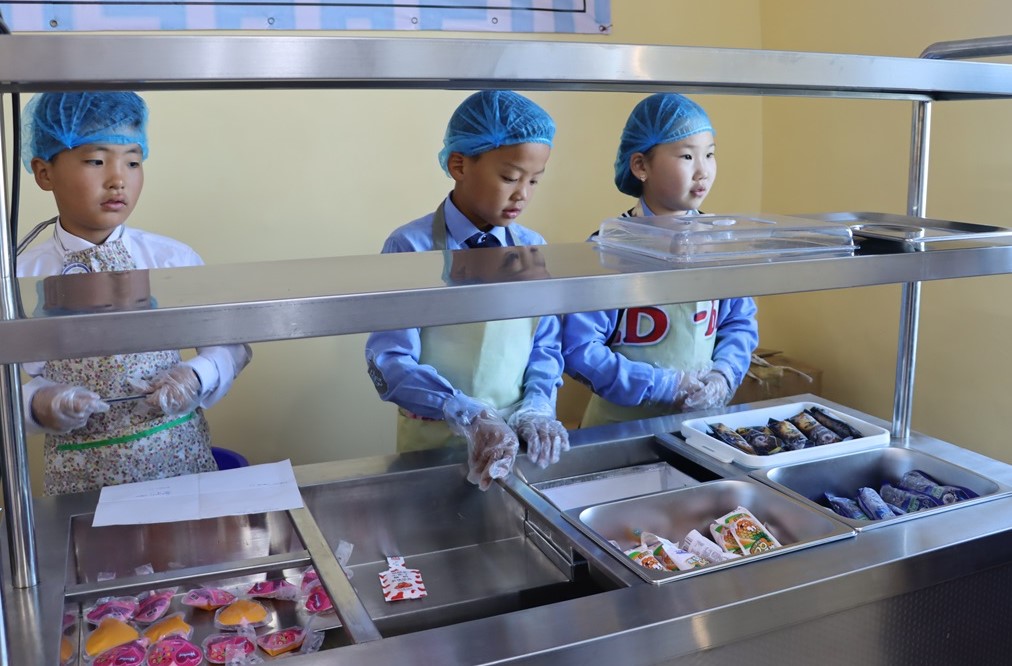“Child Producers”: Integrating the Enterprise into the School Curriculum
The children in the photo are 5th-grade students at Kharkhorin soum secondary school No. 2 in Uvurkhangai province. Outside of school hours, they are involved in producing and packaging fruit yogurt. This initiative is part of the school’s “Child Producers” program, which is being implemented as a component of the “Entrepreneurship-Focused Socio-Emotional Skills for Vulnerable Youth in Rural Mongolia” project. Students in grades 4 and 5 are responsible for preparing, packaging, and selling fruit yogurt. A large safety manual is displayed next to the packaging machine. The instructions read: “Children must follow the facilitator’s guidance at all times. They are not allowed to touch the buttons on the packaging machine while it is in operation. Children should only place the bags into the packaging nozzle and pack the finished product. Only the teacher is authorized to operate the machine’s buttons and settings. To maintain hygiene and cleanliness, students must wear a hat, gloves, and apron.” These safety rules are printed in large, clear text.
Children, dressed in hats, aprons, and gloves, are seen producing and selling the yogurt. This hands-on experience helps them develop a fondness for work from an early age and understand the value of labor. Another positive outcome is that the children are becoming more interested in their schoolwork.

This is why the students are so engaged in both their studies and the production process. There are 28 students in class 5B, who are divided into three teams. Each team is responsible for packaging and selling four types of yogurt made with sea buckthorn, blueberries, rockrose, and cranberries. Through this experience, they’ve established an efficient organizational structure. For example, on Mondays, 10 children from the first team package the yogurt, and on Tuesdays, they sell it.
The second team handles production on Tuesdays and sells the yogurt on Wednesdays. The children who produce the yogurt on Wednesdays are scheduled to sell it on Thursdays. At school, they continue the work they did in the production workshop, applying it in the classroom. For example, during their Mongolian language lessons, they prepare news reports highlighting the importance of their product, and design ads.
In math class, the children work on financial calculations for their business. The first team tracks their daily income, expenses, net profit, and average weekly income, while the next team determines their total monthly income.

The third team calculates their annual income by month. Each child drinks one bag of yogurt a day, replenishing their nutrients while earning their wages. The cost of the yogurt they drink is deducted from their income. The children’s calculations are very precise. For example, they determined that there are 22 working days in a month. Since the school covers electricity and housing costs, these expenses were deducted from their calculations.
The class calculated the unit cost of the product. For example, “One bag costs 200 MNT, and 200 bags cost 40,000 MNT (since bags are purchased in packs of 200). The cost of ingredients is as follows: 1 kg of fruit costs 15,000 MNT, 1 kg of yogurt costs 3,000 MNT, 1 kg of sugar costs 5,500 MNT, and 20 liters of yogurt costs 60,000 MNT. In the production process, 1 kg of fruit and 0.5 kg of sugar are mixed with 20 liters of yogurt, which is then packaged into 200 ml bags. Each bag is sold for 1,500 MNT.” This is how the detailed calculation and cost breakdown is made.
In the health lesson, the students discussed the benefits of fruit yogurt for the body and wrote an essay on the topic. In the drawing and technology lesson, they drew pictures of stored fruit yogurt and calculated measurements.
M.Gantuya, a 5B grade teacher at School No. 2 in Kharkhorin soum, Uvurkhangai province, presented the results of integrating production into the curriculum. She said, “The children are able to make financial calculations for the products they produce with great accuracy. Engaging in production has enahnced their interest in their studies. They are gaining a financial education at an early age and developing strong teamwork skills. By incorporating real-life examples from production into their lessons, students’ active learning participation has increased significantly. They have a clear understanding of the products they produce, how much they pack, and how many they sell each day. Using familiar examples in lessons has proven to be both more interesting and effective.
The school-based enterprise, “Child Producers”, at Kharkhorin soum secondary school No. 2, in Uvurkhangai province, is built on subgrant projects such as: radio electronics by high school students, smart trash cans, salt dough crafts, tote bags made by middle school students, finger toys, and a magic drink project by younger students.
“It is crucial that teachers and staff, instead of viewing this project as a short-term initiative, focus on enhancing the learning environment for students and the working environment for teachers. They should align it with the curriculum and make it more engaging,” said E. Bat-Orshikh, the project’s entrepreneurship consultant.
This success story is a testament to the teamwork, active participation, and innovative solutions that integrated production with the school curriculum. It was engaging, educational, and truly inspiring.

